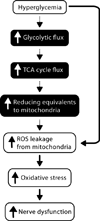Bioenergetics in diabetic neuropathy: what we need to know
- PMID: 22548617
- PMCID: PMC3589977
- DOI: 10.1111/j.1529-8027.2012.00389.x
Bioenergetics in diabetic neuropathy: what we need to know
Abstract
Progress in developing treatments for diabetic neuropathy is slowed by our limited understanding of how disturbances in metabolic substrates - glucose and fatty acids - produce nerve injury. In this review, we present the current oxidative stress hypothesis and experimental data that support it. We identify weaknesses in our understanding of diabetes-disordered metabolism in the neurovascular unit, that is, in critical cell types of the microvascular endothelium, peripheral sensory neurons, and supporting Schwann cells. Greater understanding of peripheral nervous system bioenergetics may provide insight into new drug therapies or improvements in dietary interventions in diabetes or even pre-diabetes.
© 2012 Peripheral Nerve Society.
Figures


References
-
- Boulton AJ, Vinik AI, Arezzo JC, Bril V, Feldman EL, Freeman R, Malik RA, Maser RE, Sosenko JM, Ziegler D. Diabetic neuropathies: a statement by the American Diabetes Association. Diabetes Care. 2005;28:956–962. - PubMed
-
- Brownlee M. Biochemistry and molecular cell biology of diabetic complications. Nature. 2001;414:813–820. - PubMed
-
- Chisholm DJ. The Diabetes Control and Complications Trial (DCCT). A milestone in diabetes management. Medical Journal of Australia. 1993;159:721–723. - PubMed

